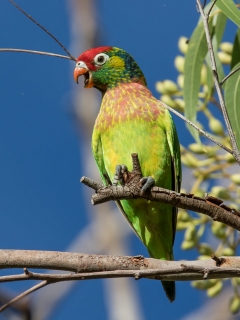Varied Lorikeet |
|
|
Also known as: Varied Lory, Variegated Lorikeet, Red-capped Lorikeet, Red-crowned Lorikeet
Photos
View in GalleryDid You Know?
The Varied Lorikeet likes to leaf-bathe, that is, it rubs its body over leaves made wet by rainshowers.Academic Research
Related publications: Psitteuteles versicolorSpecies Profile
Genus: Psitteuteles | Species: versicolor
Size:
19cm (7.4 in)
Weight:
50-60g (1.7-2.1 oz)
Subspecies including nominate:
one
Colour Adult:
Both adults in general yellow/green plumage; red lores, forehead and crown, in female duller and less far reaching; purple/pink upper breast streaked with yellow, less evident in female. Bill coral red. Eye ring white. Eye orange/yellow.
Colour Juvenile:
Much duller than adults; frontal band pale red, but crown green; pale green breast with pink markings minimal or absent. Bill brown, washed with orange at base. Eye pale brown.
Call:
Calls given in flight are shrill screeches. High-pitched chattering while feeding. When at rest emits soft twittering notes.
More Information:
Content Sources:
CITES
BirdLife International
Cornell Lab of Ornithology/Birds of the World
A Guide to Parrots of the World, Juniper and Parr, 1998
Parrots of the World, Forshaw and Cooper, 1977. 2010 edition
Parrots of the World, Forshaw, 2006.
Parrots in Aviculture, Low, 1992.
Lexicon of Parrots, Thomas Arndt.
Photos
View in GalleryDid You Know?
The Varied Lorikeet likes to leaf-bathe, that is, it rubs its body over leaves made wet by rainshowers.Academic Research
Related publications: Psitteuteles versicolorSpecies Care
Captive Status:
Not found outside Australia; limited breeding in Australia.
Longevity:
Up to 10 yrs.
Housing:
Aviary with well-drained, concrete or tiled floor, sloping toward an outlet hole, or suspended enclosure over same.
Diet:
Nectar - commercial type for small species or homemade from lactose-free baby cereal, honey and malt extract or molasses, mixed with filtered water and made fresh once or twice daily; fruit such as: apple, pear, cactus fruits, pomegranate, bananas; one or more of the following daily: carrot, fresh raw corn, green leaves of Swiss chard, lettuce, sowthistle, dandelion, rearing food made from hardboiled egg, wholegrain bread and carrot, all ground to crumbly consistency.
Enrichment:
Enjoys large, planted aviary if possible, (not vigorous chewers); also enjoys bathing so provide overhead misters or shallow water bowls. Provide bird-safe, unsprayed flowering branches to enhance foraging.
Nest Box Size:
Diagonal box 6" x 12" x 6" (15.2cm x 30.5cm x 15.2cm).
Clutch Size:
3-5
Incubation Time:
22 days
Fledging Age:
6-7 weeks
Hatch Weight:
Not recorded.
Peak Weight:
Not recorded.
Weaning Weight:
Not recorded.
Photos
View in GalleryDid You Know?
The Varied Lorikeet likes to leaf-bathe, that is, it rubs its body over leaves made wet by rainshowers.Academic Research
Related publications: Psitteuteles versicolorSpecies Wild Status
World Population:
Unknown, stable.
IUCN Red List Status:
Least Concern
CITES Listing:
Appendix II
Threat Summary:
Not globally threatened. Generally considered to be common in most habitats, but owing to frequent movements it can disappear from some areas for long periods of time. Appears to have suffered a decline in population in the north.
Range:
N Australia, from Kimberley division of W Australia east to NE Queensland.
Habitat:
Found in tropical lowland areas, its movements dictated by the availability of flowering trees. Found in a variety of other habitats such as dense eucalypt, paperbark and swamp woodlands, savanna woodland and grassland and sometimes mangroves.
Wild Diet:
Diet includes pollen and nectar from the flowers of bloodwoods Eucalyptus terminalis and E. polycarpa; also E. tetradonta and E. pruinosa, the paperbark Melaleuca leucodendron, kapok trees Cochlospermum heteronemum, Bauhinia trees and Grevillea pteridifolia. Also possibly insects.
Ecology and Behaviour:
Found in pairs, small groups and large flocks, where the paired birds stay close together. Will associate with other lorikeets. Feeds in trees such as kapok, bloodwoods and paperbarks. May be aggressive towards other pollen feeding species competing for the same blossoms.
Clutch and Egg Size:
3-5 elliptical eggs, 24.0 x 20.0mm (0.9 x 0.8 in).
Breeding Season:
May occur at any time of the year, but particularly April-August. Nest is high up in tree cavity or hollow limb.
Photos
View in GalleryDid You Know?
The Varied Lorikeet likes to leaf-bathe, that is, it rubs its body over leaves made wet by rainshowers.Academic Research
Related publications: Psitteuteles versicolorMembers Only Resources
Please log-in now to find more research, resources and tools.
Not a Member?
Find more great information:
Gain exclusive access to 600+ pages of additional research, seminars and podcasts, specialists to ask your toughest questions, and dozens of other fun resources - when you become a WPT member.
Join Today >>

































